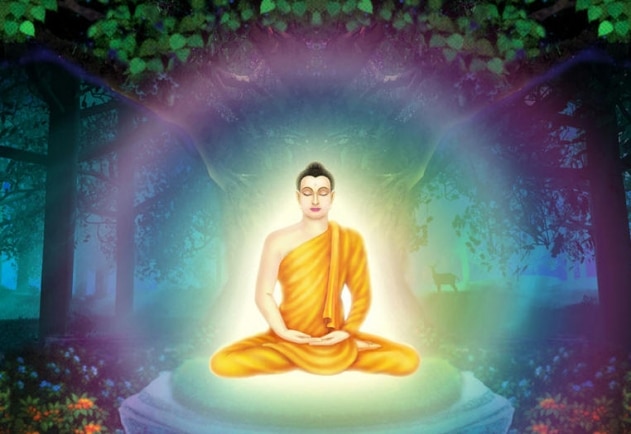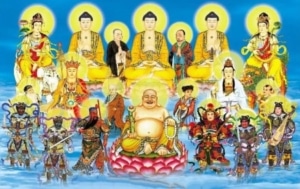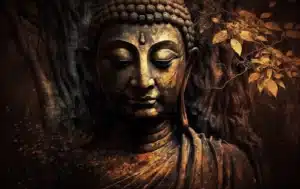When LotusBuddhas first began to explore Buddhism, we were often confused by concepts such as Buddhahood, Buddha-nature, Nirvana, and enlightenment. Why did Buddhism use so many names to describe a state of complete stillness, profound peace, and everlasting happiness? Moreover, Buddhism teaches that everything is impermanent and non-self – meaning that nothing is eternal. So, what is Buddhahood? Is it a state of everlasting bliss for the mind?
According to what is recorded in the scriptures, Buddhahood represents the ultimate goal of spiritual development and enlightenment in Buddhism, embodying a state of perfect wisdom, compassion, and peace. It is a state beyond ordinary human experience, transcending the limitations of the self and the cycle of birth and death.
For those who seek a deeper understanding of themselves and the world around them, the idea of Buddhahood offers a compelling and transformative path of spiritual growth and discovery. In this article, we will explore the meaning of Buddhahood, the journey towards its attainment, and the profound impact it can have on one’s life and the world.
What is Buddhahood?

Buddhahood in Buddhism refers to the state of complete enlightenment or awakening that a being can achieve by following the path of the Buddha’s teachings. It is the highest state of consciousness that a sentient being can attain and represents the ultimate goal of Buddhist practice.
According to Buddhist teachings, Buddhahood is characterized by the complete elimination of all mental afflictions and the realization of the true nature of reality. This state of consciousness is said to be free from all suffering, ignorance, and delusion, and is characterized by boundless compassion, wisdom, and skillful means.
Buddhahood is not considered to be a fixed or permanent state, but rather a dynamic and ever-expanding state of consciousness. It is believed that any sentient being can attain Buddhahood through diligent practice and the cultivation of the Four Noble Truths, the Noble Eightfold Path, and other essential teachings of Buddhism.
In Mahayana Buddhism, the idea of Buddhahood is also associated with the concept of the bodhisattva, an enlightened being who is committed to helping all other sentient beings attain enlightenment. Bodhisattvas are said to postpone their own entry into Buddhahood until all other beings have achieved liberation from suffering.
Is Buddhahood the same as Nirvana?
In essence, Nirvana and Buddhahood are one. It is a concept that speaks of a person who attains enlightenment and is liberated from suffering. However, the difference here is that the term Nirvana is used to refer to a person who attains enlightenment and is liberated from Samsara. While the term Buddhahood refers to a person who attains enlightenment, is free from suffering but still remains in samsara to help sentient beings escape from suffering.
What happens when you reach Buddhahood?
When one reaches Buddhahood, it is believed that they have achieved a state of complete enlightenment. This state is characterized by an innate understanding of the true nature of reality and the elimination of all ignorance, afflictions, and negative emotions.
A person who has attained Buddhahood is said to have a perfect and complete understanding of the Four Noble Truths and the nature of existence, and to have overcome the cycle of birth and death. As a result, they experience everlasting peace and happiness and are no longer subject to the cycle of suffering.
In Buddhist teachings, a person who has attained Buddhahood is considered to be a fully enlightened being and is able to help others achieve the same state through their teachings and example. They are also believed to have the ability to manifest in any form they choose to help others and to demonstrate the Dharma, or Buddhist teachings.
How does one attain Buddhahood?
A person attains Buddhahood through the practice of Buddhism and the cultivation of certain qualities and states of mind. The exact path to Buddhahood can vary depending on the specific tradition or school of Buddhism, but generally, it involves the following steps:
- Taking refuge in the Three Jewels: Buddhists take refuge in the Buddha, the Dharma (Buddhist teachings), and the Sangha (community of practitioners) as the source of guidance and support on their spiritual journey.
- Cultivating virtuous behavior: Buddhists practice ethical behavior, such as avoiding harmful actions and cultivating helpful and kind actions, as a foundation for spiritual progress.
- Practicing mindfulness and concentration: Buddhists cultivate mindfulness and concentration through meditation and other practices, which help to develop mental clarity and stability.
- Understanding the Four Noble Truths: Buddhists study and reflect on the Four Noble Truths, which provide a framework for understanding the nature of suffering and the path to liberation.
- Following the Eightfold Path: Buddhists follow the Eightfold Path, a set of guidelines for right understanding, intention, speech, action, livelihood, effort, mindfulness, and concentration, to progress on the path to enlightenment.
- Cultivating wisdom and compassion: Buddhists cultivate wisdom, which allows them to see the true nature of reality, and compassion, which motivates them to help others.
In the vast and wondrous world of Buddhism, the attainment of Buddhahood is seen as a gradual and transformative journey of spiritual growth. It’s like a seed that is carefully nurtured over many lifetimes of diligent practice, until it finally blossoms into the full radiance of enlightenment.
While the path towards Buddhahood may be long and arduous, it is believed that with determination and perseverance, anyone can eventually reach this transcendent state of complete awakening. It’s like a mountain that may seem insurmountable at first, but with each step forward, we become stronger and more resilient, inching ever closer to the summit.
What is one who attains Buddhahood called?

A person who attains Buddhahood is commonly referred to as a “Buddha.” The term “Buddha” literally means “awakened one” in Sanskrit, and refers to one who has achieved a state of complete enlightenment and understanding of the nature of reality.
In Buddhism, the Buddha is not considered a deity, but rather a human being who has achieved the highest possible spiritual state through their own efforts and practices. The historical Buddha, Shakyamuni Buddha, is seen as the first to attain this state, and his teachings and example serve as a model for all practitioners seeking to attain Buddhahood.
In the Mahayana tradition, the concept of Buddhahood is expanded upon, with the idea that all beings have the potential to become a Buddha, and that the ultimate goal is the enlightenment of all sentient beings. In this sense, the term “Buddha” refers not just to the historical Buddha, but to any being who has achieved the state of complete enlightenment.
Where does one who attains Buddhahood go after they die?
In Buddhism, it is believed that the attainment of Buddhahood does not necessarily mean an end to the cycle of birth and death, although it does bring a profound transformation to the individual’s experience of existence.
After death, a Buddha is believed to enter a state of peace and bliss, known as Parinirvana. This state marks the end of the individual’s journey through the cycle of rebirth, and they are no longer subject to the suffering of worldly existence.
It is important to note that the Buddhist understanding of death and the afterlife is different from many other religious traditions. Rather than viewing death as a one-time event that determines one’s ultimate fate, Buddhism sees death as part of the ongoing cycle of birth and death, and the ultimate goal is to end this cycle and attain a state beyond suffering.
For individuals who have not attained Buddhahood, the Buddhist belief is that their consciousness continues after death and is reborn in another realm, depending on their past actions and karmic conditions. However, the goal of Buddhist practice is to ultimately end this cycle of rebirth and attain a state of liberation and peace.





